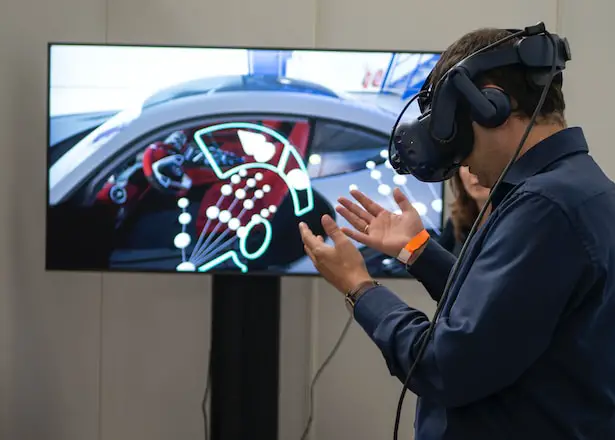In recent years augmented reality (AR) and virtual reality (VR) have emerged as groundbreaking technologies with the potential to revolutionize various industries and transform the way we perceive and interact with the world around us. This article delves into the world of AR and VR exploring their capabilities applications and the profound impact they have on diverse fields.
Understanding Augmented Reality (AR)
Augmented reality (AR) is a technology that overlays digital information and virtual objects onto the real world enhancing our perception and interaction with the physical environment. AR is typically experienced through the use of smartphones tablets smart glasses or headsets. By blending the real and virtual worlds AR offers a wide range of possibilities from interactive gaming and immersive storytelling to practical applications in education healthcare architecture and more.
Applications of Augmented Reality
- Gaming: AR has revolutionized the gaming industry allowing players to engage with digital content in real-world settings. Games like Pokémon Go and Harry Potter: Wizards Unite have brought AR gaming into the mainstream encouraging users to explore their surroundings and interact with virtual characters and objects.
- Education: AR has the potential to transform education by creating immersive learning experiences. It can bring abstract concepts to life allowing students to visualize complex subjects. For example AR can overlay interactive 3D models of the solar system during an astronomy lesson or provide historical context by superimposing virtual artifacts onto real-world locations.
- Retail: AR is reshaping the retail experience by offering virtual try-on capabilities allowing customers to visualize products before making a purchase. Virtual showrooms and interactive product demonstrations provide a more engaging and personalized shopping experience enhancing customer satisfaction and reducing return rates.
- Healthcare: AR is being used in healthcare for training medical professionals simulating surgical procedures and assisting in complex surgeries. AR overlays virtual information onto the surgeon’s field of view providing real-time guidance and enhancing precision. AR can also aid in patient education allowing them to better understand their condition through visualizations.
Exploring Virtual Reality (VR)
Virtual reality (VR) is an immersive technology that transports users to simulated environments creating a completely computer-generated experience. By wearing VR headsets or goggles users are fully immersed in a virtual world where they can interact with objects explore environments and even collaborate with others in a shared virtual space. VR technology provides a sense of presence and immersion making it a powerful tool for entertainment training therapy and more.
Applications of Virtual Reality
- Entertainment and Gaming: VR has transformed the entertainment industry offering immersive experiences in gaming virtual tours and interactive storytelling. With VR users can explore virtual worlds interact with characters and experience adventures in a way that feels incredibly real and engaging.
- Training and Simulations: VR provides a safe and cost-effective platform for training in various industries. It allows users to practice complex tasks such as flight simulations for pilots or surgical procedures for medical professionals in a realistic virtual environment. VR-based training can improve learning outcomes enhance skills and reduce the risks associated with real-world training scenarios.
- Therapy and Rehabilitation: VR is increasingly used in therapeutic settings to treat phobias post-traumatic stress disorder (PTSD) and other mental health conditions. Virtual environments provide controlled and customizable scenarios to help individuals confront and manage their fears. VR is also used in physical rehabilitation to assist patients in regaining mobility and coordination through interactive exercises.
- Architectural Design and Visualization: VR has revolutionized the field of architecture and design by allowing stakeholders to experience virtual walkthroughs of buildings and environments before they are constructed. This enables architects clients and contractors to make informed decisions identify design flaws and visualize the final product in a more immersive and realistic manner.
The Future of AR and VR
The potential of AR and VR technologies is immense and their applications continue to expand across industries. As these technologies advance we can expect to see more seamless integration of AR and VR with our daily lives blurring the boundaries between the physical and virtual realms. Advancements in hardware such as lighter and more powerful headsets and the development of more sophisticated software will further enhance the user experience and open up new possibilities.
AR and VR have the power to transform how we learn work play and interact with the world. By providing immersive and engaging experiences these technologies have the potential to revolutionize industries ranging from education and healthcare to entertainment and design. As AR and VR continue to evolve their impact will only become more profound shaping the way we perceive and experience our reality.
In conclusion augmented reality (AR) and virtual reality (VR) are immersive technologies that hold tremendous potential in various fields. From enhancing education and training to revolutionizing entertainment and design AR and VR offer exciting possibilities for innovation and advancement. By embracing these technologies we can unlock new realms of creativity interaction and exploration propelling us into a future where the digital and physical worlds seamlessly converge.

Hi, I’m Jodie! I’m a spain-Moroccan writer with a passion for imagination, adventures, magic and stories with heart.
Please don’t hesitate to contact me for any questions, suggestions, comments or feedback.

















Add comment